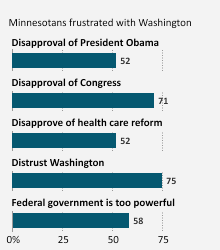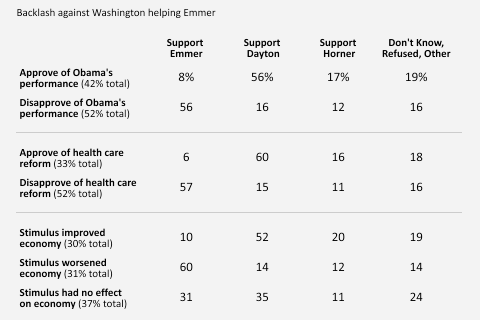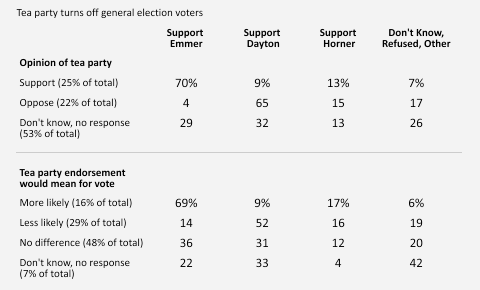Services
MPR News/Humphrey Institute Poll: Anger at Washington helping Tom Emmer
Minnesota Public RadioSeptember 2, 2010
Minnesota voters are angry, and they are taking it out on incumbents of both parties, according to the latest MPR News/Humphrey Institute poll.
The poll — conducted by Minnesota Public Radio News and the Humphrey Institute at the University of Minnesota — surveyed voters' preferences in the governor's race and approval ratings of politicians. See the full poll report and methodology, or read MPR News reporter Mark Zdechlik's report on this portion of poll.
Backlash against Washington helping Emmer
 Likely voters in Minnesota are expressing their frustrations with some of the signature reforms passed by Democrats in Washington and, more generally, with the federal government. Solid majorities both distrust government and believe that it is too powerful.
Likely voters in Minnesota are expressing their frustrations with some of the signature reforms passed by Democrats in Washington and, more generally, with the federal government. Solid majorities both distrust government and believe that it is too powerful.
Although elections often focus on local and state personalities and issues, the backlash against Washington is helping Republican candidate for governor, Rep. Tom Emmer.
Among majorities who disapprove of President Obama's performance and health care reform, 56 percent are backing Emmer. Sixty percent of likely voters who believe that the stimulus worsened the economy are also backing Emmer.

Tea party's mixed impact on Republicans
The tea party movement has injected energy into the Republican Party and helped the candidates it endorsed to win GOP nominations across the country. As Minnesota turns to the general election, the tea party is a mixed blessing for Republican candidate Emmer.

Twenty-five percent of likely voters support the tea party. An overwhelming majority of this group, 70 percent, favors Emmer. But the tea party has also ignited a backlash that can hurt Emmer. Among the 22 percent who oppose the movement, two-thirds support DFL candidate Mark Dayton.
Although the tea party's aversion to big government is shared by voters in this survey, large majorities of Minnesotans still favor existing programs like Social Security and Medicare that provide substantial, concrete benefits.
About the survey and methodology
This survey is a collaboration between Minnesota Public Radio News and the Center for the Study of Politics and Governance at the University of Minnesota's Humphrey Institute of Public Affairs. The survey was analyzed by the center. The research team was Lawrence R. Jacobs, the center's director, and Joanne M. Miller, an associate professor with the Department of Political Science. Charles Gregory provided research assistance.
The survey of 750 likely Minnesota voters was conducted August 25-29, 2010. The margin of sampling error is +/-5.3 percentage points. For smaller subgroups, the margin of sampling error is larger.
The distribution of party identification and demographics among likely voters in the full sample is as follows:

The poll is based on a landline, random-digit dial survey. From a randomly selected sample of active Minnesota telephone exchanges, random digits were added to form a complete telephone number, thus permitting access to both listed and unlisted numbers. Within each household, one adult was selected to be the respondent for the survey.
The survey data has also been weighted to accommodate for factors such as the number of telephone lines, cell phone usage, gender, age, race and ethnicity to approximate the demographic characteristics of the state's population according to the Census.
In The Spotlight
-
The Current Music Blog
Your daily note for good music, news and pop culture. With attempted jokes.


